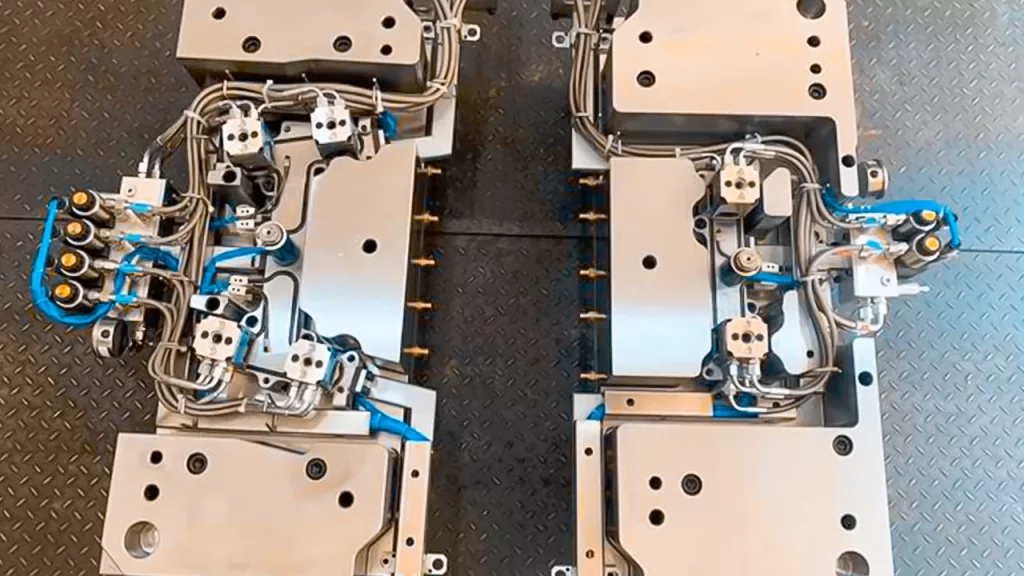Die Casting Mold and Plastic Mold are vital procedures in present day fabricating, offering flexible answers for creating complex parts with high accuracy. These cycles are fundamental across different businesses, including car, aviation, gadgets, and shopper products. This thorough aide dives into the complexities of Die Casting Mold and Plastic Mold, featuring their benefits, cycles, and applications.
Prologue to Die Casting Mold and Plastic Mold
Die Casting Mold is an assembling interaction where liquid metal is infused into a steel form under high tension. This strategy is great for creating mind boggling metal parts with tight resiliences. Then again, Plastic Mold includes forming plastic material by infusing it into a shape depression. The two techniques are generally involved because of their proficiency in making nitty gritty parts rapidly and cost-actually.
Pass on Projecting Cycle
1. Pass on Projecting Outline
Pass on projecting includes infusing liquid metal into a shape under high tension, which rapidly hardens to frame the ideal part. The interaction is known for its capacity to create leaves behind magnificent surface completions and layered exactness. Bite the dust projecting is commonly utilized for aluminum, zinc, and magnesium compounds.
2. Kinds of Die Casting Mold
High-Strain Die Casting Mold: In this strategy, liquid metal is infused into the shape at high tension, which guarantees a quick filling rate and great parts. It is utilized for creating high-volume leaves behind complex shapes.
Low-Strain Bite the dust Projecting: This procedure includes a lower infusion pressure and is frequently utilized for bigger parts. The liquid metal is brought into the shape by environmental tension or a low-pressure siphon.
Gravity Pass on Projecting: In gravity bite the dust projecting, the liquid metal is filled the shape pit by gravity. This strategy is appropriate for creating more modest amounts of parts with less complex calculations.
3. Pass on Projecting Benefits
High Accuracy and Precision: Die Casting Mold conveys leaves behind close resistances and negligible machining prerequisites.
Complex Calculations: It permits the creation of multifaceted and complex shapes that are hard to accomplish with different strategies.
Phenomenal Surface Completion: Parts created by Die Casting Mold regularly have a smooth surface, decreasing the requirement for optional completing cycles.
High Creation Proficiency: The interaction is profoundly robotized, prompting diminished work costs and quicker creation cycles.
Plastic Mold Interaction
1. Plastic Mold Outline
Plastic Mold includes infusing liquid plastic into a shape to make different parts. This cycle is flexible and can be custom fitted to deliver leaves behind various materials and shapes. Normal Plastic Mold strategies incorporate infusion shaping, blow forming, and rotational embellishment.
2. Kinds of Plastic Embellishment
Infusion Trim: In this strategy, plastic pellets are dissolved and infused into a form under high tension. It is reasonable for high-volume creation and produces leaves behind high layered precision.
Blow Trim: This procedure is utilized to make empty plastic parts by blowing air into a liquid plastic cylinder. It is usually utilized for assembling jugs and holders.
Rotational Embellishment: In rotational trim, a warmed shape is loaded up with plastic powder and turned along various tomahawks. This strategy is great for delivering enormous, empty parts.
3. Plastic Mold Benefits
- Flexibility in Materials: Plastic Mold can utilize many plastic materials, including thermoplastics and thermosets.
- Financially savvy Creation: The underlying expense of molds can be high, yet the per-part cost is moderately low, making it practical for huge creation runs.
- High Accuracy and Intricacy: Plastic Mold takes into account the development of many-sided and definite parts with tight resiliences.
- Plan Adaptability: The interaction empowers the making of intricate shapes and elements, including undermines and strings.
Looking at Pass on Projecting and Plastic Embellishment
1. Material Contemplations
Pass on projecting is normally utilized for metal parts, while plastic embellishment is utilized for plastic parts. Metals cast utilizing bite the dust projecting are for the most part more grounded and more tough than plastics. Notwithstanding, plastics offer more noteworthy adaptability concerning plan and cost.
2. Creation Speed and Cost
Bite the dust projecting is beneficial for high-volume creation because of its quick process durations and mechanization. Plastic Mold likewise offers high creation speeds, particularly for huge runs, yet the underlying mold expenses can be significant.
3. Plan Adaptability
Plastic embellishment gives more plan adaptability contrasted with bite the dust projecting. Plastics can be shaped into multifaceted shapes with fine subtleties, while pass on projecting is the most appropriate for leaves behind less intricate calculations.
Utilizations of Die Casting Mold and Plastic Embellishment
1. Pass on Projecting Applications
Car Parts: Motor parts, transmission lodgings, and underlying components.
Aviation Parts: Parts that require high strength and accuracy, like turbine edges and sections.
Customer Merchandise: Electronic fenced in areas, home devices, and tooling parts.
2. Plastic Embellishment Applications
Bundling: Jugs, compartments, and bundling materials.
Hardware: Walled in areas for gadgets, connectors, and underlying parts.
Clinical Gadgets: Parts for demonstrative gear, careful instruments, and medication conveyance frameworks.
Future Patterns in Die Casting Mold and Plastic Embellishment
The assembling business is ceaselessly developing, with progressions in innovation upgrading the capacities of both pass on projecting and Plastic Mold. Developments, for example, 3D printing molds and high level reproduction programming are reforming these cycles. The combination of Industry 4.0 advances, including robotization and information investigation, is likewise further developing proficiency and accuracy.
End
Both Die Casting Mold and Plastic Mold are indispensable to current assembling, each offering remarkable benefits fit to various applications. Understanding the complexities of these cycles assists makers with choosing the best technique for their particular necessities, prompting further developed item quality and creation effectiveness.










